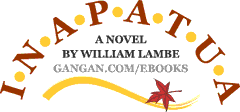First published by Cassell Australia Ltd. in 1966
(Pen name John Patrick) Copyright: William Lambe
Published online by gangan books australia in 2001
Copyright: William Lambe and Gerald Ganglbauer
This outspoken novel describes the search for identity of a young Australian aboriginal. Born with the tribal name Irritcha, he is orphaned and brought up in the city by white foster parents as Charles Carson. When the story opens he has failed his High School Certificate and missed the chance of a university place. Exhausted by the attempt to assimilate 2,000 years of alien culture, he has decided to visit his tribal kinsfolk employed at the cattle station of Table-Tops.
Half fascinated, half repelled, he agrees to join them on the ritual “walkabout” – the brief annual return to a nomadic existence. But after narrowly escaping death by thirst in the desert he soon learns to jettison his feelings of superiority along with his elegant city clothes and imitation pigskin suitcase. He survives to undergo the fearsome Lartna and Arilta initiation ceremonies and claims his tribal bride as a fully-fledged Abunda warrior. The walkabout ends, and the realities of the 20th century have to be faced. Irritcha’s attempt to return to the world he has left – now with the added difficulty of a girl bride completely unsuited to life in the city – proves even more difficult than he had feared. Only after his wife has been taken away and his whole life appears to be crumbling about him, does he recognise his true part and cease to resemble the formless, subhuman Inapatua of Abunda legend.
Dedication
Although ‘Inapatua’ is purely a novel, the Abunda tribe is more of a composite group than a myth.
In fact, the initiation rites and ceremonies described are mostly Arunta and Aranda with overtones of Myall and Warrumunga.
Though telescoped in time and shifted in place to fit the framework of the novel, fact predominates over fiction. As few anthropologists would appreciated their years of painstaking work acknowledged on the flyleaf of a novel, the dozens of reference books from which these facts were obtained have not been listed.
To those anthropologists who spent many years of their lives among the tribes, recording the basic religion of a dying segment of humanity, this book is dedicated.For Hazel
- Dreamtime
- Welcome Home
- Walkabout
- Quatcha Ingwunta
- Atna Arilta-Kuma
- Quatcha
- Arsenic and Apple-Jelly Jam
- Lartna
- Arilta
- Atua-Kurka
- Where no Birds Fly
- Red Feathers
- Requiem for Vacuum Cleaners
- Dance on the Tiles
- Helen of the Reeves Tribe
- Close up Pinish
- Dreamtime of the Buffalo
Acknowledgement
The poem “We are Going” by Oodgeroo of the tribe Noonuccal (formerly known as Kath Walker; 1920 – 1993) is used with the permission of Jacaranda Press.
The Legend
In the time before the first men and women inhabited the earth, and while the centre of Australia was covered by salt water, there dwelt in the western sky two beings who originated from nothing. From their elevated position, the self existing ones, or Numbukulla, could see far away to the east a number of Inapatua creatures. These were rudimentary human beings.The Inapatua were of various shapes and lived in groups on the edge of the salt water. They had no distinct limbs or features and did not eat or drink; yet possessed the appearance of human beings doubled up into a rounded mass. The outlines of the body could be vaguely seen. The creatures were in reality stages in the transformation of various animals and plants into people.
Coming down from their home in the western sky, armed with leilira or great stone knives, the Numbukulla took hold of the Inapatua one after the other. First of all the limbs were released and fingers and toes added by making slits in the ends of arms and legs. The figure could now stand; the nose was shaped and the nostrils bored with the fingers. A cut with the knife provided a mouth and this was pulled open several times to make it flexible. A slit on each side separated the upper and lower eyelids; the eyes were already present. Another stroke or two completed the body and thus out of the Inapatua men and women were formed.
Translated from Arunta
By Spencer & Gillen
Intro | Part One.1 | Part One.2 | Part Two | Title
